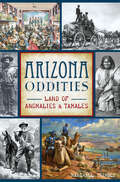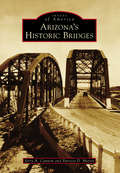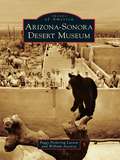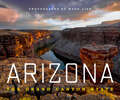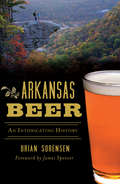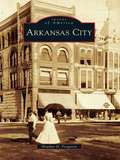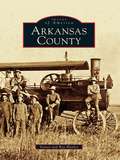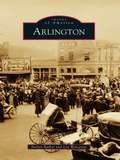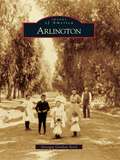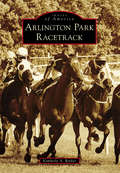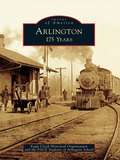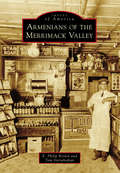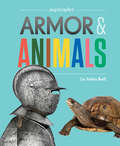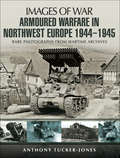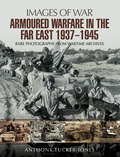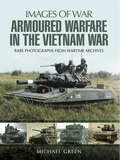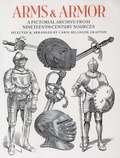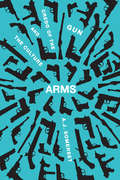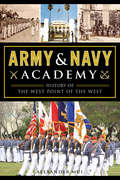- Table View
- List View
Aristotle's Poetics for Screenwriters: Storytelling Secrets from the Greatest Mind in Western Civilization
by Michael TiernoAn insightful how-to guide for writing screenplays that uses Aristotle's great work as a guide.Long considered the bible for storytellers, Aristotle's Poetics is a fixture of college courses on everything from fiction writing to dramatic theory. Now Michael Tierno shows how this great work can be an invaluable resource to screenwriters or anyone interested in studying plot structure. In carefully organized chapters, Tierno breaks down the fundamentals of screenwriting, highlighting particular aspects of Aristotle's work. Then, using examples from some of the best movies ever made, he demonstrates how to apply these ancient insights to modern-day screenwriting. This user-friendly guide covers a multitude of topics, from plotting and subplotting to dialogue and dramatic unity. Writing in a highly readable, informal tone, Tierno makes Aristotle's monumental work accessible to beginners and pros alike in areas such as screenwriting, film theory, fiction, and playwriting.
Arizona Oddities: Land of Anomalies & Tamales (American Legends Ser.)
by Marshall TrimbleArizona has stories as peculiar as its stunning landscapes. The Lost Dutchman's rumored cache of gold sparked a legendary feud. Kidnapping victim Larcena Pennington Page survived two weeks alone in the wilderness, and her first request upon rescue was for a chaw of tobacco. Discover how the town of Why got its name, how the government built a lake that needed mowing and how wild camels ended up in North America. Author Marshall Trimble unearths these and other amusing anomalies, outstanding obscurities and compelling curiosities in the state's history.
Arizona State University
by Dr Denise Bates Dr Stephanie DeluseArizona State University was founded in 1885--27 years before statehood--as the Arizona Territorial Normal School. A modest school building was erected on donated pastureland outside Phoenix and was initially dedicated to training public school teachers. The school rapidly evolved through multiple name changes and grew to four campuses and from 33 to over 70,000 students. Currently, ASU is the largest public educational institution in the United States and is also an internationally recognized research university, offering hundreds of areas of study. This book offers a photographic narrative of the institution's dynamic transformation with glimpses of the committed faculty, staff, students, alumni, and citizens who helped make Arizona State University what it is today.
Arizona's Historic Bridges
by Patricia D. Morris Jerry A. CannonArizona was once just a passage for pioneers headed west for gold, religious freedom, and cheap land. Native Americans had lived in and explored the territory for years, but it was Manifest Destiny and the western expansionist philosophy of the burgeoning US government that created the impetus for better and faster routes across the vast territory with its topographical challenges. In the 1880s, the railroads first booted their way across the landscape, following historic trails before the highways were built. The Grand Canyon and Colorado River were obvious challenges, but there were also seasonal waterways that needed crossings. The history of the state unfolds with this book, profiling the bridges that define these historic transportation routes. Many of them have been proudly restored by their communities or the state, while others are gone or are in a sad state of decline.
Arizona-Sonora Desert Museum
by Peggy Pickering Larson William AscarzaSince 1952, Bill Carr and Arthur Pack, the founders of the Arizona-Sonora Desert Museum, have inspired visitors to live in harmony with the natural world by fostering love, appreciation, and understanding of the Sonoran Desert. When the museum opened it had only four employees. Today it has more than 100 paid employees, nearly 200 docents, and close to 300 volunteers. About 85 percent of the museum is outside, where visitors can enjoy native and the endangered animals exhibited in award-winning naturalistic habitat enclosures, an innovation in exhibitory developed by the museum. Most visitors spend between two and three hours touring the Arizona-Sonora Desert Museum, but as the museum continues to grow, it is becoming harder and harder to see it all in such a short amount of time. Visitors should plan to come early and stay late!
Arizona: The Grand Canyon State
by Mark LiskBeautiful coffee-table book featuring photography from across the state of Arizona.
Arkansas Beer: An Intoxicating History (American Palate)
by James Spencer Brian SorensenArkansas�s booze scene had a promising start, with America�s biggest brewing families, Busch and Lemp, investing in Little Rock just prior to Prohibition. However, by 1915, the state had passed the Newberry Act, banning the manufacturing and selling of alcohol. It was not until sixty-nine years later that the state welcomed its first post-temperance brewery, Arkansas Brewing Company. After a few false starts, brewpubs in Fayetteville, Fort Smith and Little Rock found success. By 2000, the industry had regained momentum. An explosion of breweries around the state has since propelled Arkansas into the modern beer age.
Arkansas City: People, Places, And Events (Images of America)
by Heather D. FergusonArkansas City has often been called "the gateway to the West." The name lends a lot to describing the town--a town that was founded as a border town to Indian Territory, a major trade hub to the Indian agencies in Indian Territory, and a major transportation center for those wishing to travel through the territory and farther west. Arkansas City started off as a small town with false-fronted stores but became a bustling community where the people were forward thinkers and pushed for quality and modernization in everything they brought to the city whether that was business, industry, or entertainment. Arkansas City is known for the Cherokee Strip Land Rush of September 16, 1893, interaction with the Native Americans in Indian Territory, farming, ranching, and aircraft. Although Arkansas City was a civilized community, it was a city on the fringe of a lawless and unsettled territory where outlaws lurked and Native Americans were forced to settle. People loaded their wagons or went by train to cross through Oklahoma to Texas, New Mexico, or Arizona, leaving from Arkansas City. Due to Arkansas City's location, interaction with major figures and events in history, and its importance to travel farther west, Arkansas City was truly "the gateway to the West."
Arkansas County: Arkansas (Images of America)
by Ray Hanley Steven HanleyFirst established by the French in 1686, Arkansas Post was the first permanent European settlement in the Mississippi River Valley. It played a key role in the long struggle between France, Spain, and England for control of the lucrative fur trade. The only battle of the American Revolution fought west of the Mississippi took place in Arkansas County. Located in the heart of the Grand Prairie, Stuttgart, one of two Arkansas County seats, is known as the "duck and rice capital of the world." Bayou Meto and several lakes draw waterfowl to the area each fall, and ducks flocking to Stuttgart attract hunters from across the nation. Each November, the community hosts the World Championship Duck Calling Contest.
Arlington
by Lea Worcester Evelyn BarkerHistorians dispute the founding of Arlington. Some say Arlington started in 1848 when Col. Middleton Tate Johnson started the settlement called Johnson's Station, a forerunner of Arlington. Others say it was 1876, when the railroad arrived, or 1877, when the post office was established. Still others claim 1884 as the founding, because that was when city leaders incorporated Arlington, naming the town after the home of Gen. Robert E. Lee. Whatever date one chooses for the founding, there is no question that Arlington has grown from its frontier origins into the entertainment center of North Texas. Highlights of Arlington's development include Depression-era gambling at Top O' Hill and Arlington Downs, Progressive values in the Berachah Home for Erring Girls, higher education through the University of Texas at Arlington, and economic expansion with General Motors. More recently, energetic citizens like former mayor Tommy Vandergriff helped bring two professional sports teams to Arlington. Today the Texas Rangers and Dallas Cowboys share top billing with the city's other signature attractions--Six Flags Over Texas and Hurricane Harbor.
Arlington (Images of America)
by Georgia Gordon SerclThe neighborhood of Arlington, located about five miles southwest of downtown Riverside, was first settled in the 1870s and was later developed as a town site in 1877 by philanthropist Samuel C. Evans and William Sayward. Citrus groves flourished in the area, providing the community with a newfound wealth. Large and gracious homes were built on wide streets lined with beautiful shade trees. Arlington's commercial district at Van Buren Boulevard and Magnolia Avenue expanded to include a bank, chamber of commerce, newspaper, store, church, boardinghouse, and post office with its own Arlington postmark, in use since 1888. In the early 1900s, an electric railway was built down the center of Magnolia Avenue ending at beautiful Chemewa Park with its large trees, dance pavilion, zoo, and polo field. Today Arlington retains much of its neighborhood feeling while undergoing a large-scale redevelopment project for a future retail and commercial district.
Arlington Park Racetrack (Images of America)
by Kimberly A. RinkerBorn of one man's dream and built on 1,001 acres northwest of metropolitan Chicago, Arlington Park had its inaugural run in 1927 and celebrated its 90th season in 2017. Innovative and forward-thinking, Arlington set the standard of excellence during the glory days of racing. The famed racetrack survived a devastating fire in 1985, reopening four years later to worldwide acclaim. Over the decades, Arlington has played host to some of the most famous horses, jockeys, trainers, and owners in the sport of kings. Arlington is also home to the world's first million-dollar race--the renowned Arlington Million--and is the only Windy City racetrack to have hosted the Breeders' Cup Championships.
Arlington: 175 Years
by Eagle Creek Historical Organization PACE students of Arlington SchoolIn 1834, Robert Hurd and his family settled on a parcel of land in what is now present-day Arlington. A devout Presbyterian, Hurd named the town after his favorite church hymn. In the late 1800s, the small town of Arlington saw progress in the form of two railroads. The mid-1930s were especially prosperous, as the town enjoyed a bustling business center that included six grocery stores. The famous Arlington Homecoming Festival began in 1946 and ran for 50 years. In the 1990s, George Herbert Bush and William Jefferson Clinton made presidential campaign stops here, making history in this quiet, small town. The heart of this town can be found in its citizens, their churches, schools, and businesses, and their community park. Current and former residents alike share fond memories of their small-town lifestyle and are proud to be Arlingtonians.
Arm Knitting: 30 no-needle projects for you and your home
by Alpha30 step-by-step, chunky knit projects using the hottest needle-free trend: arm knitting.It's fast, it's easy, and it's fun. Arm Knitting features 30 guided projects for head-to-toe wearables, accessories, and cozy home goods. Each project is needle-free! Although you could create the same stitches and the same techniques with regular knitting, arm knitting gives you bigger stitches, and thicker yarns allow for more rapid results. Using just your arms, you can create your own chunky, beautiful knit goods by following the photographic instructions!Let the photography inspire you as you work through each project, whether you want a scarf for the winter, a new wreath for your door, or a blanket for your bed. From choosing yarn, to weaving in ends, to sewing pieces together, Arm Knitting guides you every step of the way.Perfect for those who don't know how to knit, this needle-free technique is suitable for beginners, giving you beautiful results in hardly any time at all.
Armenians of the Merrimack Valley (Images of America)
by Tom Vartabedian E. Philip BrownWhen one thinks of the Merrimack Valley, shoe shops and mills come to mind. For that reason, it was a hotbed for Armenian immigrants following World War I and the genocide that robbed Armenia of half its population, with some 1.5 million victims lost at the hands of the Ottoman Turkish Empire and another million people uprooted from their homes and scattered to a Diaspora. Many of these refugees came to the Merrimack Valley--settling in the cities of Haverhill, Lawrence, and Lowell--to eke out a better life for themselves and their families. Aside from sweatshop labor, they sought work as barbers and mercenaries, business owners and handymen, going to night school for better English standards and keeping their rich heritage and culture intact with their churches and community centers. Despite the discrimination they faced with their "strange" names and lifestyles, the Armenians remained tenacious and resilient, contributing to the overall welfare of their new promised land.
Armor & Animals
by Liz Yohlin BaillWhat do knights in shining armor have to do with slimy snails and porcupines? A lot, actually! Armor & Animals brings together two things kids love to provide an entryway into the world of art. The armor collection at the Philadelphia Museum of Art, beloved by its young visitors, provides the remarkable helmets, shields, and more that appear in the book, and which experienced museum educator Liz Yohlin Baill compares to the shells, scales, and spikes that protect animals.Lively text paired with bright, modern graphics and real-life armor informs kids about art and animals in tandem. A rhino crashes into a knight, teaching kids that a group of rhinos is called a crash—so stay out of the way! Dragons may be imaginary, but a fire-breathing dragon etched on armor can still make a horse look extra tough. Kids can consider the helmets, goggles, and other "armor" they use that help make their own activities safer, and connect art to their world as they learn.
Armor Up! Thermoplastics: Cosplay Props, Armor & Accessories (Ultimate Cosplay Enc Ser.)
by Christopher Tock Chad Van Wye Sammy Van WyeNext-level swords, shields, and more thermoplastic cosplay props! Working with plastics can be extremely intimidating, even to veteran cosplayers. Armor Up! Thermoplastics, the first volume in the Ultimate Cosplay Encyclopedia series, includes everything you need to know about working with plastics and synthetic materials. From basic to expert level tutorials, key professionals guide you to create the base piece and polish the finished product with techniques on modifying, color, heat form, and detail with modern materials. When warmed up, thermoplastics hardens to form a firm shell. Cosplay swords, shields, and more have a high-quality look and feel with the modern materials and pattern-making covered in the book. Key experts in cosplay and professional costuming offer their expertise to demystify working with thermoplastics and make them less intimidating! Safety first! Learn the technical information needed to safely and successfully work with modern materials Make your cosplay vision a reality with a wide range of materials and skills to produce props, armor, and accessories.
Armour and Masculinity in the Italian Renaissance
by Carolyn SpringerDuring the Italian Wars of 1494 to 1559, with innovations in military technology and tactics, armour began to disappear from the battlefield. Yet as field armour was retired, parade and ceremonial armour grew increasingly flamboyant. Displaced from its utilitarian function of defense but retained for symbolic uses, armour evolved in a new direction as a medium of artistic expression. Luxury armour became a chief accessory in the performance of elite male identity, coded with messages regarding the owner's social status, genealogy, and political alliances. Carolyn Springer decodes Renaissance armour as three-dimensional portraits through the case studies of three patrons of luxury armourers, Guidobaldo II della Rovere (1514-75), Charles V Habsburg (1500-58 and Holy Roman Emperor from 1519-56), and Cosimo I de'Medici (1519-74). A fascinating exposition of male self-representation, Armour and Masculinity in the Italian Renaissance explores the significance of armour in early modern Italy as both cultural artefact and symbolic form.
Armoured Cruiser Cressy: Detailed in the Original Builders' Plans
by Andrew ChoongThe complete set of builders’ plans for the Royal Navy’s Victorian era armored cruiser famously sunk during WWI.The builders of British warships created a highly detailed set of plans for each ship upon completion. These highly detailed, multicolored drawings represented the exact appearance and specifications of the ship as it entered service. Today, the National Maritime Museum and Seaforth Publishing are making these invaluable resources available to the public through a series of books featuring high-quality digital reproductions.This volume presents the plans for the armored cruiser HMS Cressy. Launched on December 4th, 1899, it best known for the disaster of September 22nd, 1914, in which Cressy and two sister-ships were sunk by a small submarine. Though obsolete by the First World War, Cressy-class cruisers were innovative ships in their day.In full color, with many close-ups and enlargements, these plans make every aspect of the HMS Cressy clear and comprehensible. Extensive captions point the reader to important features to be found in the plans, and an introduction covers the design’s background.
Armoured Warfare in Northwest Europe, 1944–1945: Rare Photographs from Wartime Archives (Images of War)
by Anthony Tucker-JonesThis latest volume in Anthony Tucker-Joness series of photographic histories of armored warfare records in graphic detail the role played by tanks, infantry fighting vehicles and self-propelled artillery during the decisive campaign in northwest Europe in 1944-5. In a sequence of over 200 archive photographs he shows how American, British, Canadian, and Polish armored divisions spearheaded the assault on the Third Reich, and how the Wehrmacht mounted a desperate armored defense. Tanks were required to operate in the dust of Normandy, the mud and waters of the Scheldt and Rhine rivers and the snows of the Ardennes and the forests of Germany. A succession of crucial armored engagements was fought during the D-Day landings, Operation Goodwood and the struggle for the Bourgubus ridge, the Falaise pocket, the Seine crossing, Arnhem, the German attack in the Ardennes, the Rhine crossing, in the Reichswald and during the rearguard actions and the last-ditch tank battles fought by the panzers in the Ruhr before the German surrender. Anthony Tucker-Joness photographic survey of the ultimate tank battles of the Second World War illustrates the range of armored fighting vehicles that were developed during the conflict, and it features the specialized vehicles deployed in Europe for the first time such as the Buffalo, DUKW, Weasel and Terrapin.
Armoured Warfare in the Far East, 1937–1945: Rare Photographs From Wartime Archives (Images of War)
by Anthony Tucker-JonesAnthony Tucker-Jones's photographic history is a fascinating visual introduction to the armoured battles of the Second World War in the Far East and Asia-Pacific regions, from 1937 to 1945. In contrast to the experience of the armies that fought in Europe and North Africa, in the Far East tanks remained an infantry support weapon, and their role is often neglected in histories of the conflict. Japanese armour confronted tanks deployed by the Chinese, Russians, British and Americans. Early in the war, against Chinese forces which lacked armour, the Japanese had some success, but their light and medium tanks were no match for their Allied counterparts. Later Japanese designs were better armed, but they were built in such small numbers that they could do little to stem the Allied advance. The role of armoured vehicles in each theatre of the war in the Far East is shown in a selection of over 150 rare wartime photographs that record armour in action in China, Manchuria, Mongolia, Malaya, Burma and during the battles fought for the Pacific islands.
Armoured Warfare in the Vietnam War: Rare Photographs From Wartime Archives (Images of War)
by Michael GreenThis pictorial history of the Indochina and Vietnam Wars captures the range of armored warfare used in the region through rare wartime photographs. The two conflicts that engulfed Indochina and Vietnam in the decades after World War II are generally thought of as infantry wars. But in fact, they both involved a significant amount of armored warfare. In this fully illustrated volume, military expert and Vietnam veteran Michael Green describes the many kinds of armored vehicles deployed and their contributions in combat. The ill-fated French Expeditionary Force of the Indochina War was largely equipped with World War II era American tanks—including M3 and M5 Stuart, M4 Sherman and M24 light tanks—as well as armored cars and half-tracks. Most of these eventually went to the Army of the Republic of Vietnam, but were outdated and ineffective due to lack of logistics and training. The US Army and Marine Corps build-up in the 1960s saw vast quantities of M48 Pattons, M113 APCs and many specialist variants and improvised armored vehicles arrive in the theatre. The Australians also brought their British Centurion tanks. But it was the Russians, Chinese and North Vietnamese who won the day and their T-38-85 tanks, ZSU anti-aircraft platforms.
Arms and Armor: A Pictorial Archive from Nineteenth-Century Sources (Dover Pictorial Archive)
by Carol Belanger GraftonOver thousands of years, man has developed an enormous variety of offensive and defensive weapons for use in battle as well as a vast array of armor and other protective devices. Now artists and illustrators can draw on this extensive archive for superb copyright-free illustrations of vintage arms, armor, and other battlefield paraphernalia. Choose from a rich trove of over 750 illustrations compiled from rare nineteenth-century sources. Included are detailed, high-quality depictions — arranged chronologically and, to some extent, geographically — of suits of armor, chain mail, swords, halberds, spears, pikes, lances, crossbows, axes, daggers, helmets, shields, knives, small arms, and a host of other implements, along with scenes of battle, siege, jousts, soldiers, horses, and more. Especially suitable for projects requiring a medieval or old-fashioned flavor, these illustrations reproduce extremely well. They will fill a myriad of needs for battle-related graphic art.
Arms: The Culture and Credo of the Gun
by Andrew SomersetIn Arms: the Culture and Credo of the Gun, novelist, journalist, sports shooter, and former army reservist A.J. Somerset offers up one of the first looks at the gun as our pre-eminent cultural symbol of power and asks how it got that way. <P><P>Pouring through the various cultural battlefields of 19th- and 20th-century North America, including film, literature, music, videos games, and history, Somerset charts how the gun went from a tool in the hands of the earliest pioneers, used to defend the homestead and put food on the table, to a kind of totem, instantly capable of dividing communities. Sharp-eyed and acerbic, sure-handed and sportive, Arms presents an intellectual and cultural history that is certain to enrage, entertain, and provoke debate, while showing that the gun cultures of Canada and the United States may not be so different after all. If guns, as the NRA often exclaims, do not kill people, Somerset shows how the idea of the gun has become something many believe worth dying for.
Army & Navy Academy: History of the West Point of the West
by Alexander MuiOnce a staple of American society, military schools are a dying breed, with fewer than thirty remaining. Historically, most military academies existed in the South and along the East Coast. However, Colonel Thomas A. Davis pushed this tradition westward when he founded the San Diego Army and Navy Academy in 1910. Davis pioneered a novel education and leadership training structure for young men that predated the Boy Scouts and JROTC Program. From this single institution sprang the Brown Military Academy, Davis Military Academy, San Diego Military Academy and more. Author Alexander Mui chronicles the endurance of this revered academy through countless trials, wars, economic depressions and the nationwide military school decline until it remained the last traditional military academy west of the Rocky Mountains.

